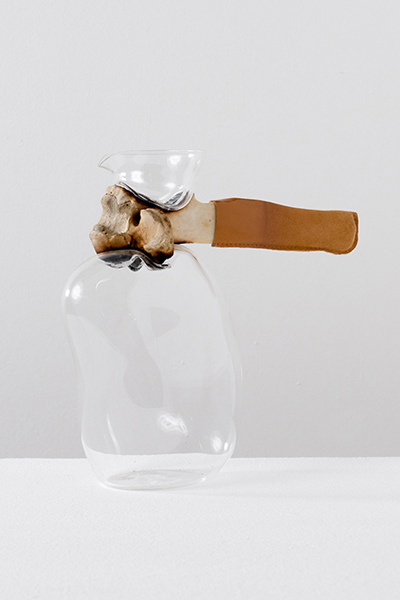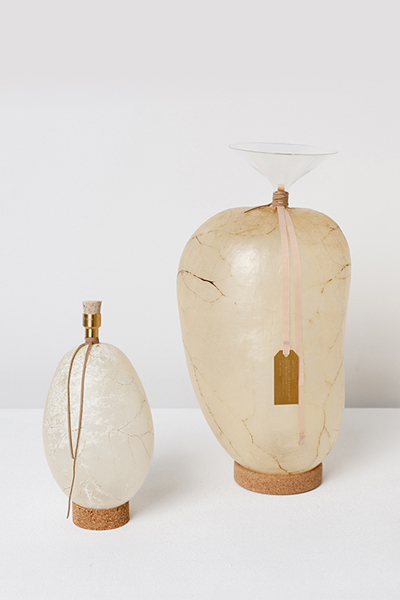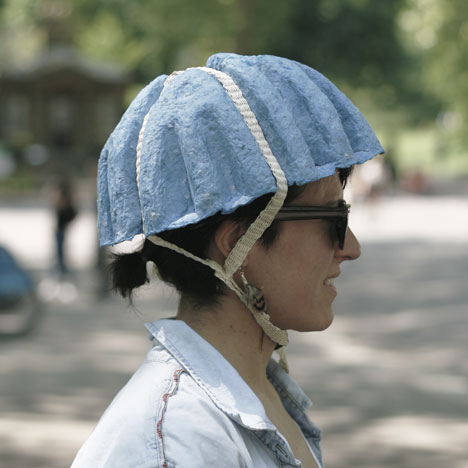On first sight I loved Formafantasma’s designs, they held a certain elegance and beauty in their simplicity, the back to basics materials, gathered from the natural world juxtapose themselves, feeling both strong and delicate at the same time. It brought out my childhood fascination, I recalled scavenging for treasures on the British beaches of my childhood and taking them home to make new creations or to merely bring a glimpse of the natural world into my home in the dense, man-made city. These designers took this fascination, a primal human action of scavenging/collecting to an industrial level, contemplating the natural world by sampling, casting, weaving, reshaping their materials, making connections between unlikely materials to form a delicate balance between the rough and smooth, fragile and strong.
Bone Jug, 2012 (Cowbone, leather, mouth blown glass) from Craftica series
Their work is fascinating also because of the delicacy with which they deal with their subject matter, not only with the physical properties of the materials but the symbolic and historical meaning. Their project Craftica for instance is an investigation into leather, highlighting our ancient roots of hunting for food, tools and body protection. They channel prehistoric tools, durable tools for survival made of bone and stone, combining the simplicity of these ancient tools into a modern aesthetic.
Tools of bone were originally a practical use of materials but are now becoming a design statement, a hark back to our ancestral heritage, a sign of simpler times within a society too lazy to source sustainable, durable materials, instead opting for the cheap, easy version –mass produced materials with processes which are quickly damaging our environment.
Wolffish stool, 2012 (Wood, vegetal tanned wolffish leather)
Bladders water containers, 2012 (Pig and cow bladders, brass, mouth blown glass, cork) from Craftica series
It is designers such as Formafantasma who are questioning this use of cheap, destructive materials, replacing them with more sustainable/unique alternatives. With each piece you can see where the materials came from and you question the story behind each material; the fish skin leather –a by-product of the fish food industry, in Alaska alone there are 2 billion pounds of fish by-products every year including fish skins which are often dumped into landfill or back into the ocean, left to pollute the water and kill off species’ (x article on an Alaskan start-up using salmon skin leather), or the cork leather –by harvesting the species of oak tree, Quercus Suber of their bark to form cork every 9 years rather than harming the trees it helps them live longer. Therefore, these designs are refreshing in a society where we don’t know where so many of our products come from.
However all of this comes at a price, an unlabelled price, a sale inquiry at a high-end gallery. Does this step into the elite then diminish the beauty or sustainability of these objects? These products, inspired by those that were once precious items necessary for survival then become an expensive showpiece. The matters of sustainability aren’t so important, it then becomes about the recognition and the money. Is it enough that they are potentially inspiring a next generation of designers, or inspiring the people that visit the Stedelijk museum to think more about where their everyday products come from? This engagement with the issue of the way we deal with our resources engages the viewer but it doesn’t solve the problem, instead it benefits the designer, giving them the recognition of being a sustainable designer making unique products.
So, are there sustainable, affordable designers out there who are actually impacting the way we live? Of course there are many design companies trying to come up with solutions to these problems, a good example is material science company, Evocative who have developed Mushroom Materials, a sustainable building material made from agricultural byproducts and mushroom Mycelium; these provide a natural alternative to common synthetic packaging and the company have experimented with using this as both packaging and a material for product design, producing stools and tables, as well as offering an affordable DIY pack. This opens up a way of buying products that are good for our environment, in addition to encouraging people to make their own products. A number of different designers have experimented with Mushroom Materials, for example architectural studio The Living built an organic tower Hy-Fi for the annual MoMA temporary structure, a biodegradable material was therefore perfect for the temporary building. By creating this innovative material Evocative have opened a door to a new future material that could replace the depleting materials that are destroying our environment.
Grow It Yourself, Mushroom Material from Evocative $10 Hy-Fi, 2014 The Living Pavilion made with Mushroom Material
Another example of innovative sustainable design is the Paper Pulp Helmet designed by Tom Gottelier, Bobby Petersen and Ed Thomas, who made use of the many discarded newspapers around London’s transport system and recycled these to form helmets which would potentially cost £1, thus a low-cost environmentally-friendly solution to bike safety in the city. The design was just a prototype but the cheap and recyclable material/process is a perfect example of the future direction of design we need to take in order to preserve the planet.
Paper Pulp Helmet, 2013 Tom Gottelier, Bobby Petersen and Ed Thomas
In my research I found it very difficult to find these examples, searching for ‘sustainable product design’ offers a lot of high-end designers with very expensive products or similarly to Formafantasma prices aren’t shown and they are presented in galleries more as a work of art than a sustainable design, therefore they aren’t presenting an immediate solution.
Perhaps we need government schemes to encourage designers/bigger companies to use better materials and to sell these products at affordable prices so they can compete with the mass-produced products that are often badly made and harmful to the environment. In recent years we have seen many countries across the world introduce a charge for plastic bags in supermarkets. This due to the fact that around 8m tonnes of plastic makes its way into the world’s oceans each year, posing a serious threat to the marine environment. The charge was introduced by the government to try to influence consumer behavior and the result is massively affecting the amount of plastic waste, in England the number of single-use plastic bags was reduced by 85% over the first six months. If governments enforced similar rules on other products; introducing taxes to products with harmful materials then perhaps it could influence consumers to opt for better sourced products.
We, as consumers have brought about this problem, being so materialistic yet simultaneously too lazy to source sustainable products; we are struck by the aesthetic of a product and buy it without thinking where it came from or the ethical implication, just as I was struck by Formafantasma’s work in the Stedelijk, not considering the possible downsides of the designs. If there was a large scale enforcement of better quality, environmentally-friendly products then maybe consumers would think more before they buy.








